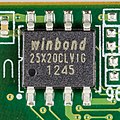This article needs additional citations for verification .(February 2014) |
| SeaBIOS | |
|---|---|
 SeaBIOS is the default BIOS for QEMU | |
| Developer(s) | Kevin O'Connor |
| Initial release | February 25, 2008 |
| Stable release | 1.17.0 [1] / 10 June 2025 |
| Repository | |
| Written in | C |
| Platform | x86 |
| Included with | KVM, QEMU |
| Standard(s) | SMBIOS |
| Available in | English |
| Type | BIOS |
| License | LGPLv3 |
| Website | www |
SeaBIOS is an open-source implementation of an x86 BIOS, serving as a freely available firmware for x86 systems. Aiming for compatibility, it supports standard BIOS features and calling interfaces that are implemented by a typical proprietary x86 BIOS. SeaBIOS can either run on bare hardware as a coreboot payload, or can be used directly in emulators such as QEMU and Bochs.
Contents
Initially, SeaBIOS was based on the open-source BIOS implementation included with the Bochs emulator. The project was created with intentions to allow native usage on x86 hardware, and to be based on an improved and more easily extendable internal source code implementation. [2] : 3–5
